We're an affiliate
We hope you love the products we recommend! Just so you know, we may collect a share of sales or other compensation from the links on this page at no additional cost to you. Thank you if you use our links, we really appreciate it!
Yorkshire Terriers, or Yorkies, are small compact-sized dogs with charming appearances and plucky personalities.
These little dogs are loyal, fearless, and dedicated to their owner’s way of life. They are highly favored for their long silky coat which sets them apart from the crowd.
Yorkshire Terriers are often considered one of America’s top dog breeds according to yearly rankings from the AKC’s registry.
In this guide, we will go through everything you need to know about Yorkshire Terriers with complete coverage of this dog breed.
Whether you’re a new Yorkie parent or you’re planning to bring one into your household, this guide will provide you with answers to your commonly asked questions.
A Brief History of Yorkshire Terriers
Yorkshire Terriers can trace their humble beginnings to England in the mid-1800s. During this period, there was a wave of manual laborers coming to Yorkshire, England from Scotland.
The Immigrants from Scotland came with a variety of Terrier dog breeds with them into their new labor fields in England.
The workers were continuously troubled by the increasing number of vermin in their cotton mines, and they desired to breed a working terrier to help them control these little rodents.
To achieve their goals, the workers selectively bred quite a few Terrier breeds including the Clydesdale Terriers with Tan and Black Terriers and Paisley Terriers.
Some historians postulate that several Maltese dogs were used during the initial breeding stage of the first Yorkies.
These little pups were initially known as the Broken Haired Scotch Terrier and then changed to the Toy Terrier.
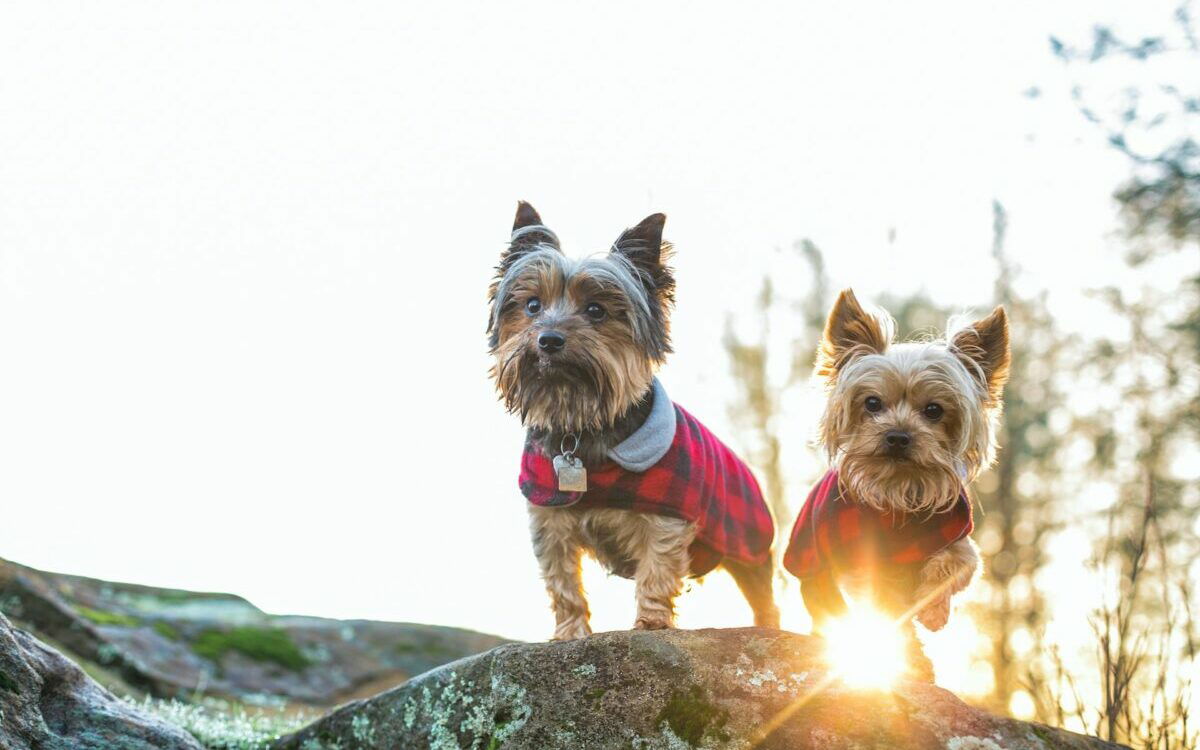
It wasn’t until 1874 when the Yorkies were finally given the name ‘Yorkshire Terrier’ due to their initial breeding location in Yorkshire England.
The Yorkshire Terrier dogs were deployed in textile mines and wool mills to help employees control the destructive vermin and rats.
Yorkies were selectively bred to track down rodents and small animals that sought shelter in underground dens and burrows.
These charming canines were also loved by hunters – who would carry them to their hunting fields to help chase badgers, hunt foxes, and other small game.
Yorkies built a brave mindset and courage over time to fight wild animals since they would become aggressive and confrontational when cornered in a dark den.
It was during the reign of Queen Victoria that these lovely pups changed from being ferocious hunters into being companion dogs.
The British aristocrats and the upper middle class embraced the lovely unique appearance of these little dogs and their compact structure.
The popularity of these rat-hunters grew immensely in the UK and the working class would slowly move them from the forests and mines into their homes.
Yorkshire Terriers cemented their place in dog shows across the UK, and owning a small dog started to get trendy by the day.
By 1872, Yorkshire Terriers had already made their way into the US where they were warmly received for their dedication to work and silky appearance.
The American Kennel Club (AKC) registered their first Yorkshire Terrier dog breeds in 1885. This recognition opened the door to many dog enthusiast homes and hearts.
5 Fascinating Facts About Yorkshire Terriers
1. Yorkshire Terriers were named after their breeding region in England
Yorkies got their name from Yorkshire, England – a county where most of their breeding took place during the mid-1800s.
2. Yorkshire Terriers change color as they grow
Yorkshire Terriers have unique genetic material that makes them change color. Their fur is fine, straight, and typically a striking combination of blue (diluted black) and gold.
Yorkie puppies are born with a black and tan coat. The black color will change to blue and the tan will change to gold as the dog matures.
The color transition usually kicks off when the puppy is six months old and it will continue until they’re one or two years of age.
3. Yorkies don’t shed too much
Yorkshire Terriers are often considered a hypoallergenic dog breed because they shed very little dander, making them a great choice for individuals with allergies.
Their long, fine, silky hair traps allergens, reducing the risk of reactions. While no dog is entirely hypoallergenic, Yorkies come close and can be a superb choice for allergy-prone individuals.
4. Yorkshire Terriers are decent watchdogs
Yorkies are small breed dogs, meaning they may not confront strangers. However, they have instinctual traits to detect unusual activity and may alert their caregivers to potential threats.
It’s because of this instinctual trait to defend that Yorkshire Terriers can bark a lot even to normal visitors and large pets.
Luckily enough, you can train your Yorkie to slow down on barking if you feel like they’re barking too much to the extent of annoying your neighbors.
5. Yorkies’ glamorous coat resembles human hair in texture
The hand feeling of the luxurious silky coat on Yorkshire Terriers resembles that of human hair. This makes it prone to tangling and matting if not brushed regularly.
The good side is that Yorkshire Terriers don’t have an undercoat, so they don’t experience excessive shedding similar to what double-coated breeds have.
Yorkshire Terrier Puppies
Welcoming a new Yorkie puppy home is an experience filled with satisfaction and anticipation in equal measures. These tiny canines are highly priced for their cuteness and small size.
However, you should remember behind their swishing flowing coats lies a need for proper care, consistent training, and early socialization.

Yorkshire Terrier puppies are intelligent and inquisitive, making them eager learners but also prone to mischief when left unchecked.
As a new puppy owner, you’ll have the privilege of shaping their behavior, teaching them valuable commands, and witnessing their playful antics in real-time.
While the journey of raising a Yorkshire Terrier puppy may have its fair share of challenges, the rewards of a loving and devoted companion will make it all worthwhile.
Yorkshire Terrier Types (with pictures)
1. The original Yorkshire Terrier
As the name suggests, these are the closest variations of the original Yorkshire Terrier dog bred in England during the mid-1800s.

The standard Yorkshire Terrier are known for their playful nature and thrill-seeking instincts which leaves them anticipating the next adventure.
The most distinguishable physical feature of plain Yorkies is their coat color which comes in either blue, black, tan, or gold shades.
2. Black Yorkshire Terriers
Most Yorkshire Terriers’ coat has two color combination, but we also have those with a solid black appearance throughout their coat.
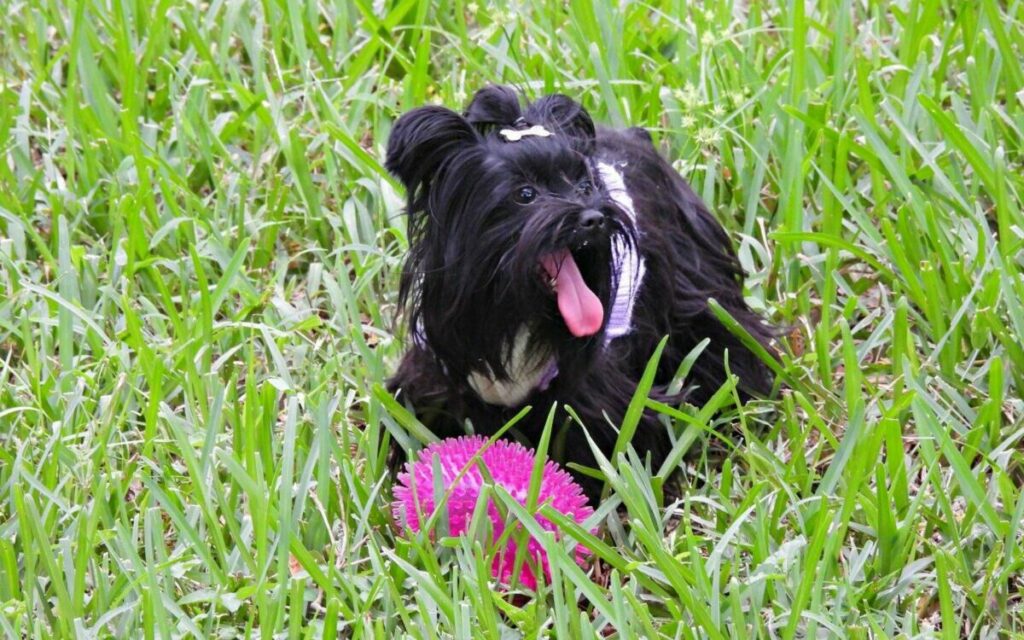
Black Yorkies are very rare to come across but they have the same personality and temperament as their standard counterparts.
3. Parti Yorkies
Parti-colored Yorkshire Terriers are different from the typical black and tan Yorkies because they are tri-colored.
These loyal dogs have a combination of three colors on their coat. Their unique color combination sets them apart in a crowd and captures the hearts of many Yorkie enthusiasts.
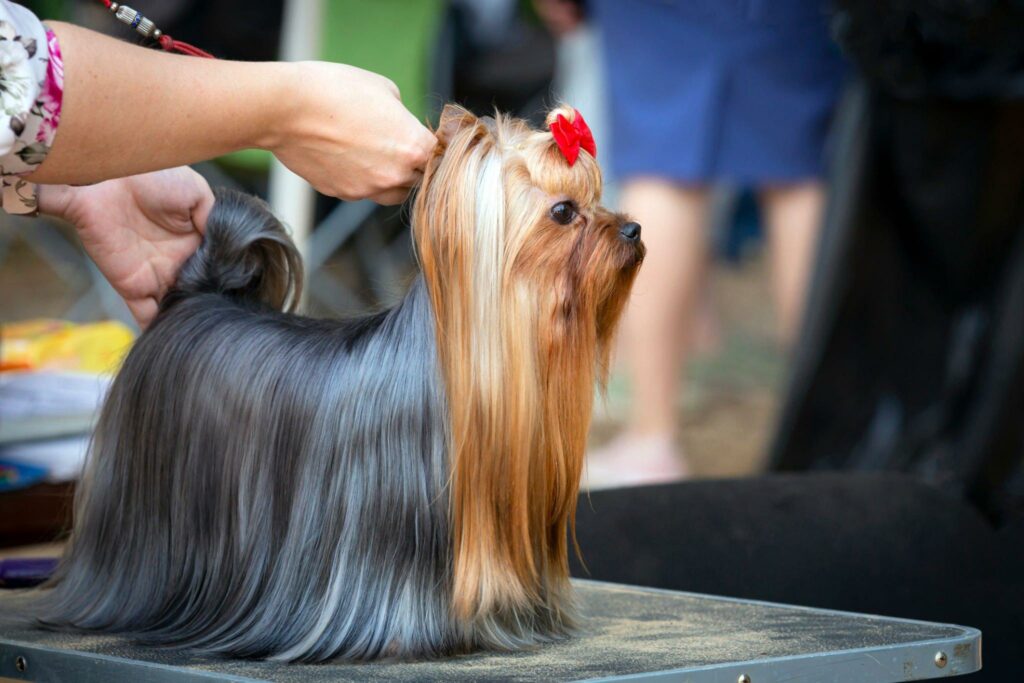
While their coat may differ, parti Yorkies maintain the same playful and affectionate nature as their two-colored counterparts, with an added flair of individuality.
4. Biewer Terrier
The Biewer (pronounced Biever) Terrier originated in Germany in 1984 from the kennel of Yorkie breeders Gertrude Biewer and Werner.
Dog lovers from America started importing this breed into the US in the year 2002, and they quickly became a favorite for many people.
These terriers were bred from a parti-colored Yorkshire Terrier with random markings. To date, Biewer Terriers are famed for their beautiful coats with huge proportions of white patterns.

Biewer Terriers were subjected to extensive DNA analyses and were found to be purebred Yorkshire-based dogs.
Alongside Yorkies, the DNA analysis revealed the presence of genetic materials from bichon frisé, Maltese, and Havanese dog breeds.
Biewer Terriers were officially admitted into the American Kennel Club in 2014, and they are eligible to take part in toy group competitions.
5. Mismarked Yorkshire Terriers
Mismarked Yorkshire Terriers are not a different kind of this breed, it’s only that their coats sport unexpected color patterns.

The officially AKC-recognized colors of Yorkies are black, tan, blue, and gold. Any other coloration is considered a mismarked combination.
Mismarked Yorkies can be an excellent choice for people looking for dogs with a unique appearance that is not found with any other individual.
6. Teacup Yorkies
The standard Yorkshire Terriers are already small in stature. However, you can get a Teacup variation which is an even smaller version of the regular Yorkies.
Fully grown Teacup Yorkies will often have an average weight of about 4 pounds which makes them easy to carry on the go.
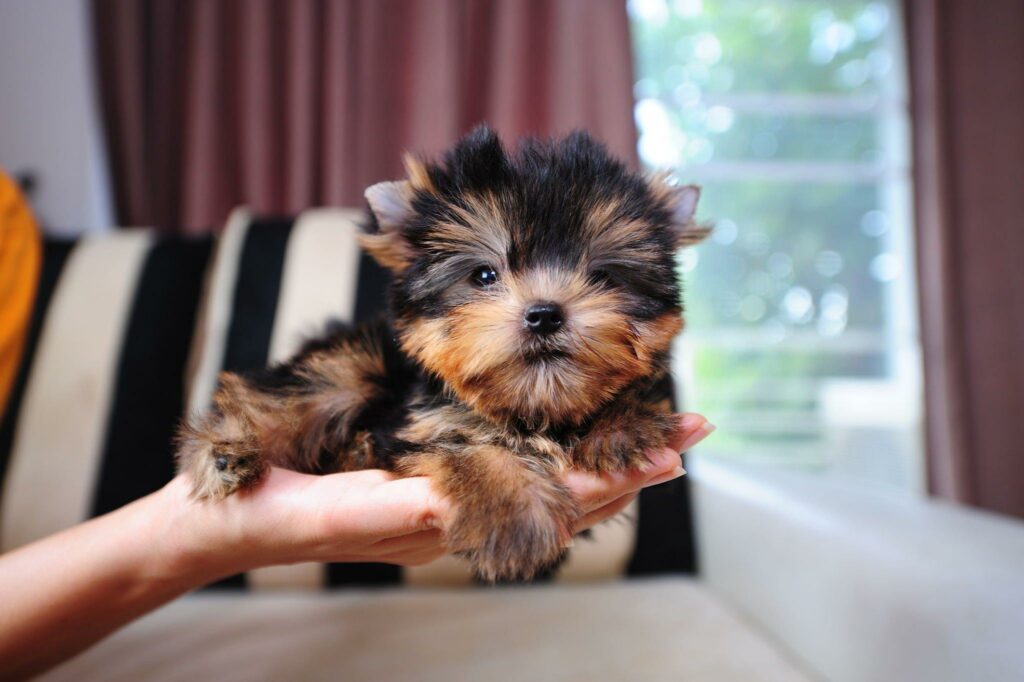
These miniaturized versions of Yorkies can be prone to certain medical conditions and organ failure because of their diminutive stature.
If you own this pocket-size pup, we strongly suggest you take them to the vet’s office for regular wellness checks to detect potential chronic issues before they become serious concerns.
7. Designer Yorkies
Designer Yorkshire Terriers, also known as Yorkie Mixes or Hybrid, is a combination of a purebred Yorkshire Terrier and a different dog breed.
Obtaining genes from two different dog breeds results in a cross-breed dog with a unique appearance and a combination of the best traits from both parents.
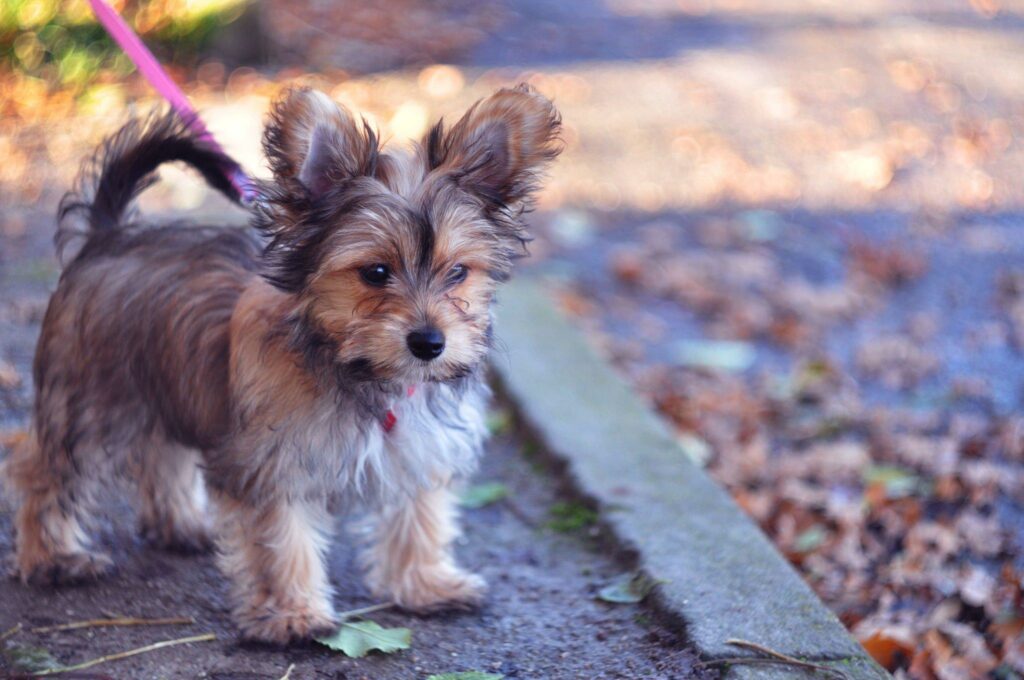
A good example of a popular designer Yorkie is Chorkie – which comes from a cross between a Yorkshire Terrier and a Chihuahua.
A designer Yorkie is a good choice for people looking for the best personality and temperaments from two different dog breeds combined in one.
Yorkshire Terrier Physical Characteristics
1. Size and Weight Range
A fully grown Yorkshire Terrier can weigh anywhere between 4 to 7 pounds while their female counterparts have an average weight range of 4 to 6 pounds.
In terms of stature, mature male Yorkies have a shoulder height of between 7 to 8 inches while females are a little tinier with an average height of 7 inches.
2. Coat Color and Texture
One of the most distinguishing highlights of Yorkies is their luxurious coats which comes in a unique appearance, pattern, and texture.
The officially recognized solid colors of purebred Yorkies are blue, black, tan, and gold, with precise color separations for the markings.
AKC lists the following color combinations for purebred Yorkshire Terriers:
- Black and Gold
- Blue and Gold
- Black and Tan
- Blue and Tan
- Parti-colored: Black, White, and Tan
These lovely canines have a soft and glossy coat texture that resembles that of human hair rather than feeling like typical dog fur to the touch.
3. Distinctive features
One of the most characteristic features of Yorkshire Terriers is their elegant, silky coat which sets them apart from the crowd.
You’ll also not fail to notice their erect V-shaped ears which stand high and upright to give them an alert expression.
These loyal canines also have small round-shaped dark eyes and button-like black noses which makes them look like little bears.
Yorkies have a thin tail crowned with silky fur which adds a touch of elegance to their swishing coat during dog shows.
Yorkshire Terrier Temperament and Personality
Yorkies are small dogs but they have big personalities which makes them a popular choice among many households.
These little pups have a bright and loving temperament towards their human caregivers, with greater tendencies to play or get naughty.
Yorkshire Terriers can form strong bonds with their favorite family members and may be weary of unwelcome guests or potential threats.
Most Yorkies love to snuggle in cozy areas during the day and they can also stay vigilant to watch over the household.
While Yorkies are a great addition to any family with kids, they can do well with older children who know how to handle small-breed dogs.

Make sure to teach your kids how to interact with dogs since rough play can push Yorkies to the limits and they may react negatively to provoking children.
If you’re in a multiple-pet household, we recommend socializing your Yorkshire Terrier with other pets as soon as possible. These little dogs are highly adaptable and they can get along with other pets.
Novice dog owners looking for small-sized dogs can hardly go wrong with Yorkshire Terriers. They have a stable persona and eagerness to learn which can help first-time owners in training.
Yorkshire Terrier Intelligence
Yorkshire Terriers are quick learners, thanks to their impressive mental acumen. These little pups have the innate ability to understand human feelings and communicate effectively.
According to research done by canine psychologist Prof. Stanley Coren, Yorkies were ranked #34 out of 138 dog breeds tested for obedience and working intelligence.
Yorkshire Terrier Health and Lifespan
Average lifespan
Yorkshire Terriers have an average life expectancy of about 13 – 16 years, which is a comparable range for most small-breed dogs.
Carol Sault’s Yorkies named Candy and Tom are believed to be the oldest dogs in Britain at the age of 26 years as of 2020.
This is enough proof that your Yorkshire Terrier can enjoy a longer life provided they receive the right care and boundless affection.
Common health issues and genetic disorders
Yorkies are generally healthy dogs, but they can be prone to certain medical conditions due to several factors including poor breeding.
Some of the common health problems affecting Yorkies include:
- Trachea collapse
- Patella luxation
- Dental problems
- Bladder stones
- Kidney stones
Preventive measures for good health
Before getting a Yorkie from a trustworthy breeder, make sure you certify all documentation for health clearance.
Dogs from backyard breeders can be susceptible to several health problems which may be difficult to handle.
You’ll also want to feed your Yorkie a consistent balanced diet with a nice touch of all essential nutrients and minerals. It helps to consult a vet for tailored advice on what to feed your dog.
In addition to a proper diet, make sure to take your Yorkie out for regular exercise to keep them in good shape and with a healthy weight.
Taking your Yorkie to the vet for regular physical and medical exams is a great way of monitoring their wellness status. This will allow for early intervention in case of chronic issues.
Your veterinarian will also ensure your little dog receives all the core vaccines and recommended booster shots to keep their body strong against canine communicable diseases.
Yorkshire Terrier and Allergies
Yorkies have a sophisticated, silky, flowing coat that can trap allergens and sheds very little fur. This makes them categorized as hypoallergenic dog breeds.
As much as there’s no allergy-proof dog breed, Yorkies can be a great choice for allergy-prone individuals because they don’t have to deal with heaps of pet dander and fallen fur.
Watch out for other allergens in dogs including urine and saliva to reduce the likelihood of suffering a negative reaction.
Yorkshire Terrier Grooming Needs
Coat Maintenance
The flowing coat in Yorkies requires fair grooming to keep them in top condition. If your Yorkie has a long coat, make sure to brush them daily using a slicker brush to prevent matting.
The coat fringes should also be trimmed regularly to prevent dragging and excessive swinging.
Yorkies have lots of hair on their head, which should be trimmed or held with a band to prevent them from covering the eyes.
Many Yorkshire Terrier owners escape this grooming demand by taking their little pups to a pet salon for professional grooming and hair clipping.
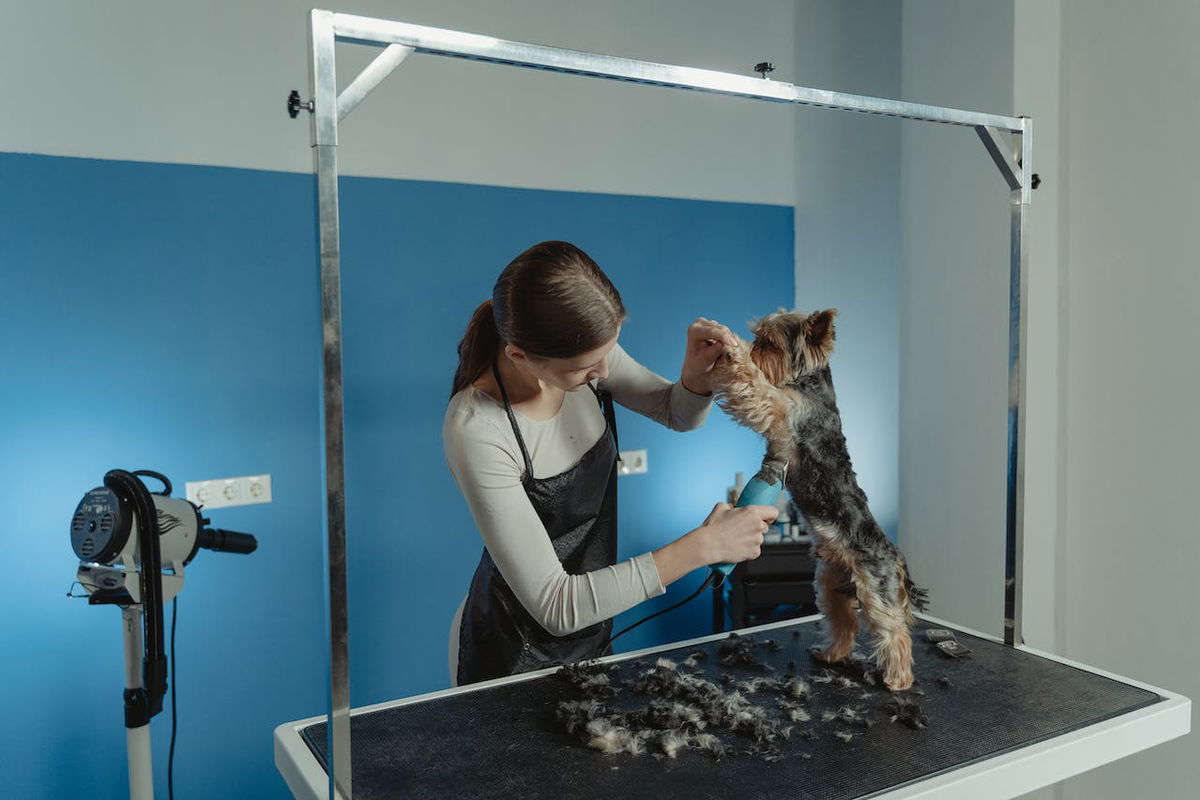
You can bath your Yorkie every two or three weeks using canine shampoo to keep their coats looking soft and shiny. Regular washing also helps remove dirt and doggy odor from the coat.
Be wary of excessive washes since they can strip off natural oils from the dog, causing the skin to become dry and flaky.
Ear cleaning
The ever-alert V-shaped ears of Yorkies are open to dirt and pathogens which can cause severe infections if not monitored.
Plan on cleaning the ears with a soft cotton ball dipped in a vet-approved ear cleanser for the best results. Be gentle with the dog’s ears to avoid pushing foreign objects deep inside the canal.
Nail Trimming
Monthly nail trims are necessary to keep your dog’s paws in great condition and to enhance comfort when walking.
Dental Care
Yorkies’ teeth can be brushed every day using a soft toothbrush and canine-specific toothpaste to maintain good oral hygiene.
Yorkshire Terrier Exercise and Activity Levels
Daily activity needs
Adult Yorkies can thrive when offered 30 minutes to 1 hour of daily physical activities and brain games. This period can vary depending on your dog’s age and health condition.
You can divide the exercise time into manageable portions throughout the day, to prevent them from getting worn out with long activities.
Suitable activities and games for Yorkshire Terriers
Although Yorkies are small in size, they can comfortably take part in several activities designed for medium-sized dogs.
The following are some of the suitable activities you can schedule for your healthy Yorkshire Terrier to keep them fit:
- Short walks
- Jogging and running
- Treasure hunts
- Hide and seek
- Playing fetch
- Obstacle course
- Indoor activities
- Puzzle games

Importance of mental stimulation
In addition to physical activities, offering your Yorkie interactive gaming sessions has a positive effect on their overall well-being.
The following are some of the advantages of mental stimulation for Yorkshire Terriers:
- Playing brain games reduces the escalation of boredom which helps prevent destructive activities such as chewing and scratching.
- Spending quality time with your Yorkie, teaching them new things, and engaging in interactive play strengthens your bond and fosters your relationship.
- Offering treat-dispensing toys and puzzle games can challenge your Yorkie’s brain and improve their problem-solving abilities.
- Consistent brain games can reduce emotional distress and anxiety in Yorkies, helping them become calm and with a stable temperament.
Yorkshire Terrier Training and Socialization
Yorkies are brilliant little dogs who can take up training with less repetition, even though they can be dominant on occasion.
These loyal pups can respond well to positive reinforcement training methods, which seek to reward progress.
Plan to start training your Yorkie from their puppyhood days and continue with them into adulthood and elderly years.
Some Yorkshire Terriers can be difficult to housetrain. This is because they can become stubborn at times and they dislike going outside, especially during harsh weather conditions.
It’s therefore important to practice patience and consistency during housetraining, and don’t shy off from starting over again until you reinforce good habits.
Aim to socialize your Yorkie puppy as soon as they get comfortable in their new home. You can achieve this by exposing them to different people, animals, and settings.
Yorkshire Terrier Living Conditions
Because of their small sizes, Yorkshire Terriers can thrive in apartment living although they need regular opportunities to play.
You can meet your Yorkies’ activity demands by taking them out for evening strolls and setting up indoor playing areas along your corridors.
Yorkies can be good escape artists, so you’ll want to puppy-proof your house to prevent them from getting into messy areas.
Yorkshire Terrier Diet and Nutrition
It’s recommended to stick to high-quality dog food for your Yorkshire Terrier. Your vet nutritionist may advise you to go for dry kibbles that are sizeable for small-breed dogs.
For effective portion control, it’s best to discuss your dog’s nutritional needs with your vet for tailored advice on what suits your dog.
Offer plenty of clean drinking water to your Yorkie by placing water stations in strategic locations within your home.
Monitor your dog’s snack intake to prevent excessive calorie consumption and overeating, which may put your Yorkie at a higher risk of obesity.
Yorkshire Terrier Pregnancy and litter size
Yorkshire Terriers, being toy breed dogs, can carry a pregnancy for about 58 to 68 days.
However, the average gestation period for most Yorkies is 63 days. If your Yorkie has not given birth by the 67th day, it may be time to call your vet.
Most Yorkies can give birth to a litter size of between 1 and 5 puppies, however, some individuals may surpass this range with the risk of stillbirth.
Conclusion
Yorkshire Terriers are compact-sized dog breeds but they pack so much personality and affection in their small stature.
Although they can be occasional lap dogs, these little canines are far from being couch potatoes. Yorkies are descendants of working dogs, an inherent trait that is still active today.
Offering a balanced diet and enough chances to play or exercise will jointly help improve the well-being of your Yorkshire Terrier.
Laura is the founder of Furs'n'Paws. She is a also a pet writer and expert with more than 20 years of experience of working with dogs and cats. She developed a very strong love for animals at a young age. Her passion led her to establish a thriving pet sitting and dog walking business in Dubai. As an expert in pet training, behavior, and nutrition, Laura is committed to helping pet owners and pet lovers by offering high-quality information on a wide range of topics.


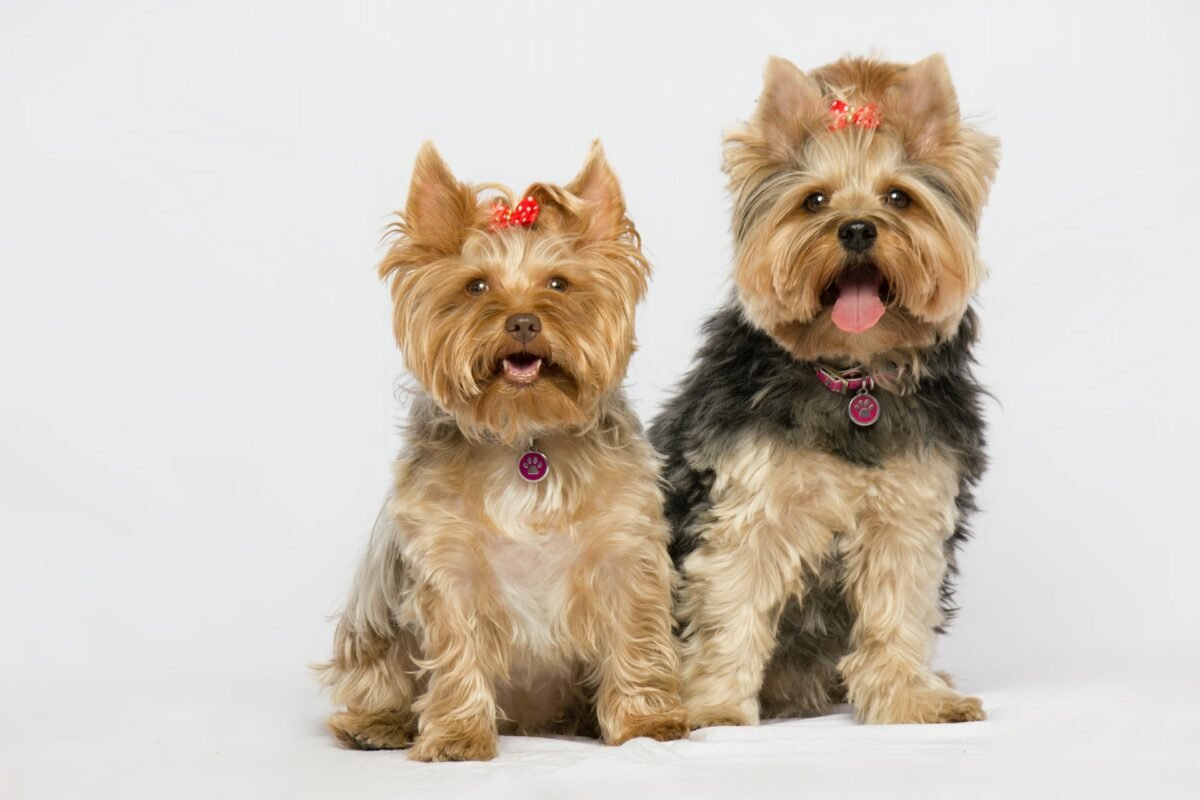
No responses yet